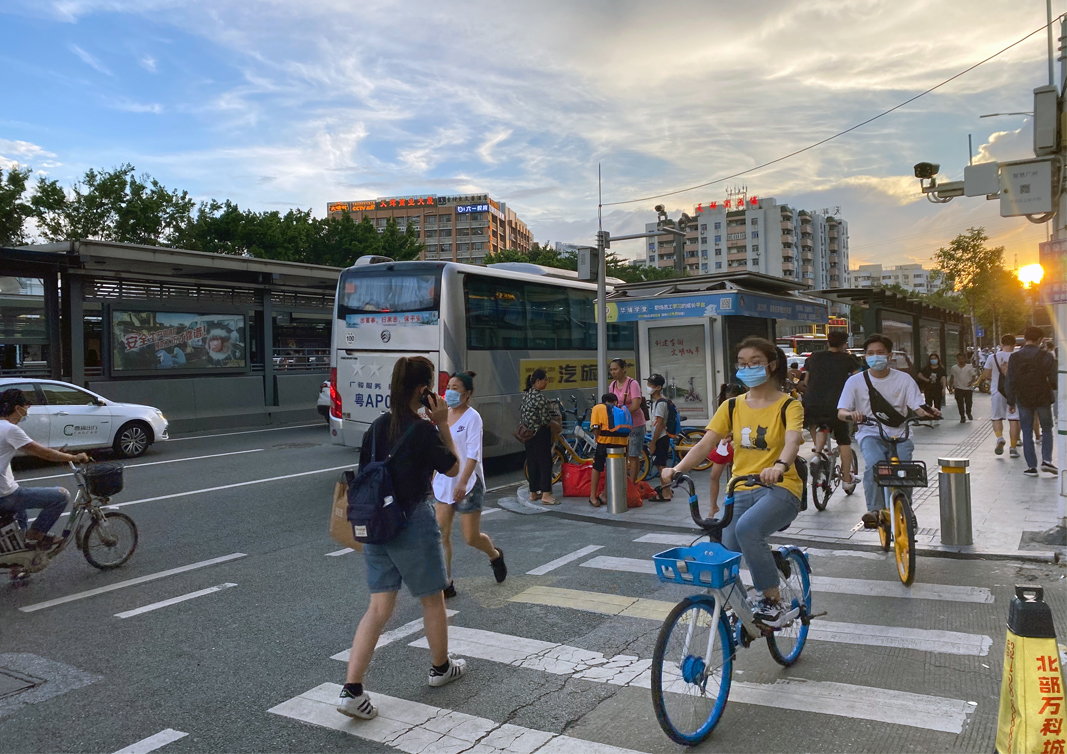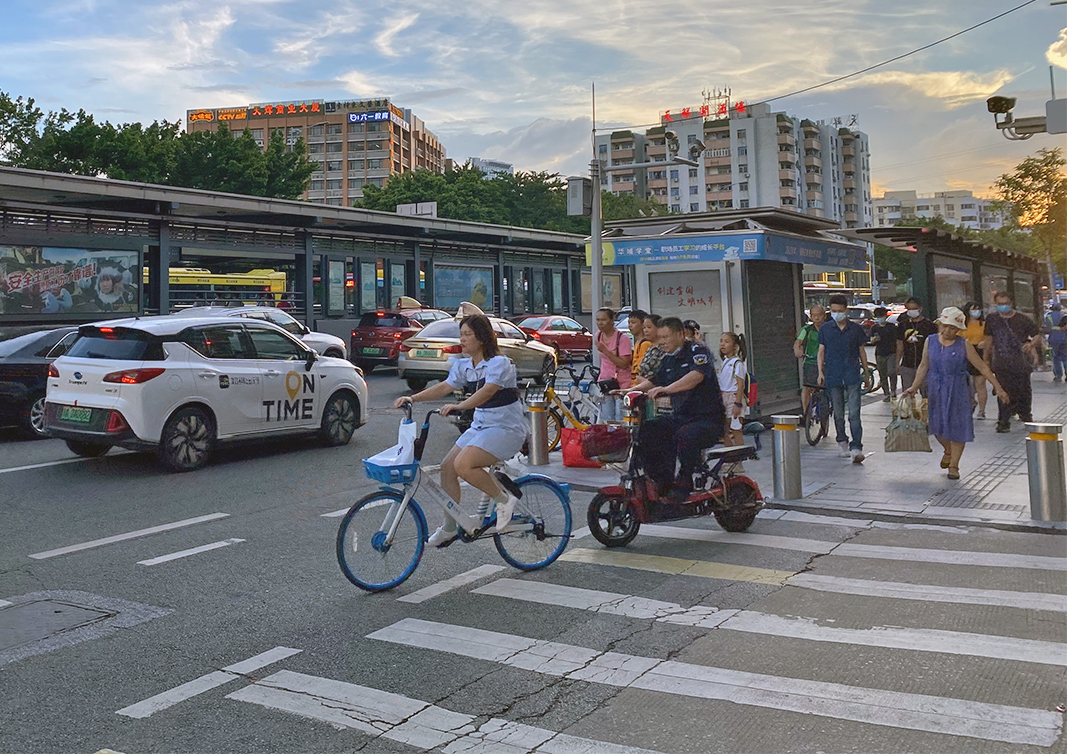Guangzhou -- 16 August 2020
Every August Far East Mobility counts the bicycle volumes at two locations along the Guangzhou BRT corridor during the Friday morning and evening peak time periods. The 2020 count reveals a resurgence in bike sharing and continuing increase in ebikes. Overall bicycle volumes more than doubled from 2019 in the morning peak at Huajing Xincheng, and increased by 15% at Tangxia during the evening peak. The post-Covid boom in cycling in general and bike sharing in particular provides a second opportunity, after the initial dockless bike sharing boom of 2017, for the city to take advantage by implementing pro-cycling policies and infrastructure.
How long will the post-Covid boost to cycling last? The experience with the boom and bust of 2017-2018 suggests that much will depend on whether the government implements measures to promote cycling and consolidate the mode shift.
Bike sharing usage has fluctuated wildly since the dockless bike sharing systems were first introduced in mid-2016. An initial boom in bike sharing in 2017 was followed by an equally precipitous plunge in 2018 as a range of restrictions were introduced, including a ban on new bikes which prevented fleet renewal, and nearly all of the operators went out of business. By 2019 bike sharing had once again increased due to an influx of tens of thousands of new bikes from two new systems led by conglomerates Alibaba (Haluo) and Meituan (Qingji) in June. The second boom in bike sharing has taken place post-Covid in 2020, with bike sharing more than tripling from 606 per hour to 1,973 per hour at Huajing Xincheng and accounting for half of all bikes.
There has been no improvement to infrastructure or policies regarding bike sharing in 2020, and the increase in new bikes associated with the new operators had already occurred at the time of the 2019 counts. The increase in bike sharing usage in 2020 is therefore likely primarily due to an increase in cycling following the Covid-19 outbreak in January 2020. How long will the post-Covid boost to cycling last? The experience with the boom and bust of bike sharing in 2017-2018 suggests that much will depend on whether the government implements measures to promote cycling and consolidate the mode shift.
Ebikes accounted for nearly half of all bikes at Huajing Xincheng and nearly two-thirds of all bikes at Tangxia, with substantial increases in both locations compared to a year ago. Ebike volumes at Huajing Xincheng more than doubled from 2019, from 778 per hour to 1,846 per hour, and increased by 22% at Tangxia. The robust and increasing demand for ebikes is less sensitive to the vagaries of bike sharing trends, as the ebikes are personally owned, but will be heavily influenced by government policies allowing them to operate, and infrastructure provision. Since 2018 enforcement of the ban on ebikes has been relaxed, but no measures have been taken to promote or provide ebike infrastructure. As the photos below show, ebikes sometimes operate on the walkway, sometimes in the bike lanes (where they exist), and sometimes on the roadway. No attempt has been made to provide secure ebike parking or promote their usage. If such measures were taken, usage of ebikes would surely rapidly increase.

 The Tangxia survey location, with bike share bikes, ebikes, taxis, long-distance coach, ride-hailing vehicles (Caocao and On Time) and BRT station. Bikes are mixed with pedestrians and vehicles on the road and walkway, with no bike lanes provided.
The Tangxia survey location, with bike share bikes, ebikes, taxis, long-distance coach, ride-hailing vehicles (Caocao and On Time) and BRT station. Bikes are mixed with pedestrians and vehicles on the road and walkway, with no bike lanes provided.
Regular bikes accounted for around 90% of bike trips in 2014, with negligible ebikes and around 10% of trips using the dock-based bike sharing system first introduced along with the Guangzhou BRT in 2010. By 2017 regular bikes had fallen to around one-third of trips and ebikes were beginning to emerge as the police relaxed the enforcement of a ban on ebikes introduced when motorcycles were banned in Guangzhou in 2007. As both bike sharing and ebikes took hold, regular bike usage collapsed in 2018 and now accounts for around 5% of all bike trips.
Key findings from the 2020 counts include:
- Bicycle usage has increased significantly after Covid-19, more than doubling at Huajing Xincheng and exceeding the 2017 volumes by 30%. (In Tangxia, the overall volume is still slighly below the 2017 peak which was associated with the first bike sharing boom.)
- Both bike sharing and ebike usage has increased in 2020, especially at Huajing Xincheng where both modes approximately tripled compared to a year earlier.
- Ebikes are increasingly the dominant mode, despite operating in a gray area where usage is tolerated rather than encouraged or even legally allowed.
- Regular bikes have declined to around %5 of cycling trips, far outweighed by bike sharing and ebikes.
Whenever the policy, supply or demand situation allows, demand for bikes surges, suggesting significant suppressed demand that could be taken advantage of to greatly increase the bike mode share in Guangzhou. This can be seen in the initial bike sharing boom in 2017, the relaxation of the ebike ban in 2018, and the post-Covid bike sharing return in 2020. Will Guangzhou this time around meet the opportunity by providing pro-cycling policies and especially infrastructure? So far, there is no sign of such measures being taken.
Bikes mostly use the walkway but some, primarily ebikes, also use the roadway at the Tangxia count location.
 Bikes, ebikes and pedestrians queue to cross the road at the Huajing Xincheng count location. In the background, buses queue to enter the BRT station.
Bike lanes at the survey location in Huajing Xincheng implemented as part of the BRT project in 2010. The lanes are not wide enough for the very high bicycle volumes of more than 4,000 per hour on this side of the road, leading to bikes on the walkway and roadway.
Location of counts carried out in August 2014, 2017, 2018, 2019 and 2020.
Bikes, ebikes and pedestrians queue to cross the road at the Huajing Xincheng count location. In the background, buses queue to enter the BRT station.
Bike lanes at the survey location in Huajing Xincheng implemented as part of the BRT project in 2010. The lanes are not wide enough for the very high bicycle volumes of more than 4,000 per hour on this side of the road, leading to bikes on the walkway and roadway.
Location of counts carried out in August 2014, 2017, 2018, 2019 and 2020.